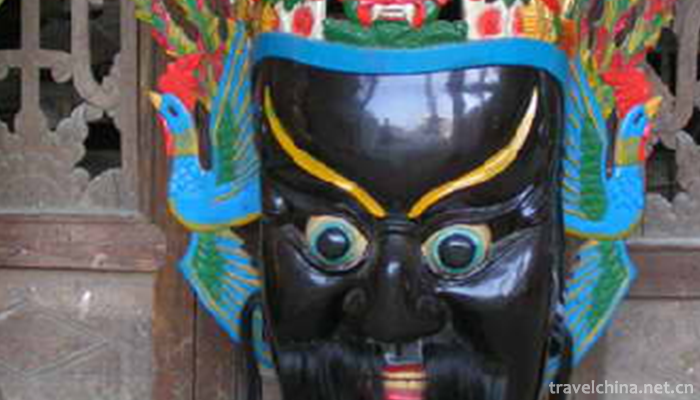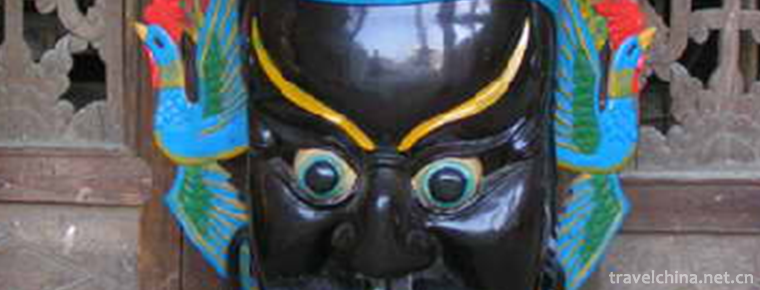Pingxiang Xiangdong Nuo Mask
Pingxiang Xiangdong Nuo Mask
Nuo mask is an important part of Nuo culture. It is used in Nuo etiquette, Nuo dance and Nuo opera. Nuo mask in eastern Hunan is an excellent traditional Chinese sculpture with a long history. Eastern Hunan is under the jurisdiction of Pingxiang, the "Coal Capital of the South of the Yangtze River", and it is the west gate of Jiangxi. Existing Nuo mask sculpture in Eastern Hunan originated in the Qing Dynasty. It was handed down from Taizhang, Hunan Province, and has been handed down for three generations. It inherited the Nuo face sculpture skills of Song Dynasty. Its technology is mature and its mask is simple and exquisite. It is a rare cultural heritage in the field of Chinese sculpture.
Pingxiang Xiangdong Nuo Mask was listed as the first national intangible cultural heritage list in May 2006.
Historical Origin
In Pingxiang, Jiangxi Province, the legend of "copper mask" is widely circulated. It is said that the ancient Nuo masks were all made of copper. More than a hundred years ago, because of the "blasphemy of the gods", they disappeared and were carved in camphor wood instead. There is a popular saying that the emperor of Da'anli took turns to do it. It refers to five Nuo teams fighting for the last copper mask, and finally mediated by the patriarch. Five Nuo teams take turns to worship the copper mask every year.
Nuo is an ancient cultural phenomenon in China, in which the spirit chases ghosts and prays for blessings and avoids disasters. Masks are endowed with mysterious religious and folklore meanings in both Nuo Festival and Nuo Opera performances. Pingxiang Nuo masks, originally more than 4000 pieces, now more than 700 pieces, production time from the end of the Yuan Dynasty, Ming and Qing Dynasty to the Republic of China.
The sculpture of Pingxiang Nuo Mask contains the wisdom and ingenuity of artists. It inherits the belief and understanding of the past generations of artists in Nuo, worships the gods of ancestors, hates ghosts and evil spirits, and expresses vividly through the production of masks, so that people can still feel the tremendous attraction of ancient ancestors inviting gods to drive ghosts.
artistic characteristics
Pingxiang Nuo masks carved for camphor wood are mostly painted and painted to depict a rough, simple, solemn and gorgeous artistic image. Nuo face modelling is mostly based on ancient celebrities. It pays attention to the deep characterization of the characters. The images are different and vivid.
The carving techniques of Nuo masks in eastern Hunan are divided into Tang Dynasty carving method and Song Dynasty carving method. Tang Dynasty carving method is crude and Song Dynasty carving method is more elaborate. Existing Nuo mask sculpture techniques in eastern Hunan were introduced from Hunan in the Qing Dynasty and have been passed down to three generations in eastern Hunan, mainly in the Song Dynasty. The mask carved by this method is simple and exquisite in style and complex in craftsmanship. Today, the inheritors can carve 440 complete figure Nuo faces of the Song Dynasty.
Nuo mask's modelling, pays attention to the characterization of the character. Carving artists use exaggeration and realism to carve vivid images of gods in accordance with mask personality requirements, using knives instead of pens, combining relief, carving through, round carving, line carving and other techniques. Although Nuo mask has been endowed with complex and mysterious meanings of various religions and customs, it itself is a plastic art, following its own artistic laws and principles.
The shapes of Nuo masks are often different according to the different roles. Its performance techniques mainly use the changes and decorations of the five senses to complete the portrayal of the characters'bravery, ferocity, ferocity, majesty, severity, stability, deep, calm, heroism, arrogance, treachery, comedy, loyalty, integrity, rigidity, abnormality, kindness, gentleness, beauty, kindness and so on. From the theatrical point of view, masks have the function of artistic endorsement, which role is generally wearing what mask are exquisite. At the same time, once various kinds of mask shapes are displayed, people will get infinite artistic beauty. Beauty of fierceness, beauty of ferocity, beauty of ferocity, beauty of vigour, beauty of britain... All of them are displayed.
Mask carving artists are known as "virgins" who carve masks professionally. In the people's consciousness of Nuo culture circle, the mask is the symbol and carrier of the gods. How to treat the mask, we often have to abide by the conventions and regulations. When making, tea, rush, rice and medicines are placed in small square holes carved behind the top of the mask, which are sealed with ointment and called "abdominal storage". After killing chickens, taking blood and smearing masks, and "shining" the forehead and eyes, according to artists, masks become viable gods. The opening ceremony should be held beforehand for the use of masks and the closing ceremony for the storage of masks. If women are not allowed to touch the mask and wear it, the making, use and storage of the mask are all men's business. Men wear masks to show that the gods have possessed themselves. They are not allowed to speak and act at will.
Inheritance Significance
There are many kinds of Nuo masks in Eastern Hunan. It takes more than ten sets of procedures to process raw materials into finished products. The facial expression of mask and its decoration have specific cultural connotation and significance, exquisite sculpture technology, simple facial expression, exaggerated techniques, and obvious regional style. Because the hand-carved Nuo mask technology is very difficult, takes a long time, and young people are reluctant to learn, so the Nuo mask sculpture in eastern Hunan has been scarce. Nowadays, the modern mechanized production mode is entering the production industry of Nuo masks, which promotes the further marketization of Nuo masks in eastern Hunan, thus leading to the disappearance of many unique handicraft techniques.
In addition, the traditional Nuo painting spectrum is mostly destroyed in various historical turmoil, there is only a complete Nuo painting spectrum, because of the age, damage is also very serious. From all the above, we can see that the carving skills of Nuo masks in eastern Hunan are in an endangered state and need to be rescued and protected urgently.
The state attaches great importance to the protection of intangible cultural heritage. On May 20, 2006, the intangible cultural heritage was approved by the State Council and listed in the first batch of national intangible cultural heritage list.


-
1.Pavilion of Prince TengTengwang pavilion
Tengwang Pavilion, one of the three famous buildings in the south of the Yangtze River, is located on the East Bank of Ganjiang River along the Yangtze River Road in the northwest of Nanchang City, Ji
Time 2018-12-08 -
2.Changlu Tourist Xiubo Garden Scenic Area
Changlu Tourist Xiubo Park, or Changlu Environmental Resort Farm (hereinafter referred to as "Changlu Farm"), became the national 5A scenic spot in November 2014. It is the only national 5A
Time 2019-03-17 -
3.Babu Zhai soup
Babaozhai soup is a traditional dish of Guangdong Province, which belongs to Cantonese cuisine. The soup tastes elegant and light, fresh and tasty, nutritious and has strong nourishing function.
Time 2019-03-27 -
4.Enshi dulcimer
Enshi Yangqin, also known as Enshi Silk String, was made up of Hunan Opera, Southern Opera, Chu Tune, folk minor, instrumental music licensing scholars and
Time 2019-04-28 -
5.Ear song
"Earsong" is also known as "Decorative Red". In Bai language, "ear" means simple son, and "song" means dance. It originated in the mountainous Bai nationality i
Time 2019-04-28 -
6.Hanju Opera
Han Opera, a local traditional drama in Wuhan, Hubei Province, is one of the national intangible cultural heritage.
Time 2019-05-02 -
7.Loba Costume
Clothing custom is an important manifestation of human material and spiritual cultural life, with a long history. The Loba people live in dozens of rivers and valleys in the vast Loba area, which are
Time 2019-05-15 -
8.Legend of Mount Tai
Taishan legend is one of the folk legends in Shandong Province. According to legend, the history of the Theocracy of Taishan God in charge of life and death can be traced back to the pre-Qin period. A
Time 2019-06-18 -
9.Civil Aviation Flight University Of China
The school is directly under the Civil Aviation Administration of China. Its predecessor was established in May 1956 with the approval of Premier Zhou Enlai. Chairman Mao Zedong appointed the aviation
Time 2019-08-31 -
10.Fried peanuts
Fried peanuts is a dish made of peanuts and other materials. It belongs to the family dish and serves wine. When drinking, people often choose this dish as the next dish.
Time 2020-03-15 -
11.Neijiang secondary industry
By the end of 2019, there were 329 Industrial Enterprises above Designated Size in Neijiang City, and the added value of industries above designated size increased by 9.5%. The added value of the five traditional pillar industries increased by 9.8%, including
Time 2020-12-16 -
12.Dazhou highway
Dazhou is one of 179 main hubs of highway transportation in China and one of 12 regional secondary hub cities in Sichuan Province. It is a secondary logistics center city in national layout planning and an important logistics hub city in Western Chin
Time 2020-12-20